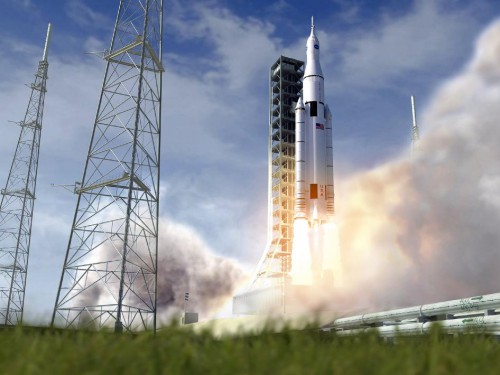
WASHINGTON — NASA has awarded grants to nine universities for advanced development activities for the nation’s next heavy-lift rocket, the Space Launch System (SLS).
The agency is providing approximately $2.25 million that will be shared by all the proposals under this NASA Research Announcement to seek innovative and affordable solutions to evolve the launch vehicle from its initial lift capability to a larger, future version of the rocket, which will carry humans farther into deep space than ever before. NASA sought proposals in a variety of areas, including concept development, trades and analyses, propulsion, structures, materials, manufacturing, avionics and software.
“Partnering with academia on SLS advanced concepts brings new ideas and vitality to NASA and expands the SLS team of rocket scientists beyond just the agency,” said William Gerstenmaier, associate administrator for Human Exploration and Operations at NASA Headquarters in Washington.
The selected universities and their proposals are:
— “High Electric Density Device for Aerospace Applications,” Auburn University
— “Challenges Towards Improved Friction Stir Welds Using On-line Sensing of Weld Quality,” Louisiana State University
— “A New Modeling Approach for Rotating Cavitation Instabilities in Rocket Engine Turbopumps,” Massachusetts Institute of Technology
— “Algorithmic Enhancements for High-Resolution Hybrid RANS-LES Using Loci-CHEM,” Mississippi State University
— “Characterization of Aluminum/Alumina/Carbon Interactions under Simulated Rocket Motor Conditions,” Pennsylvania State University
— “Development of Subcritical Atomization Models in the Loci Framework for Liquid Rocket Injectors,” University of Florida
— “Validation of Supersonic Film Cooling Numerical Simulations Using Detailed Measurements and Novel Diagnostics,” University of Maryland
— “Advanced LES and Laser Diagnostics to Model Transient Combustion-Dynamical Processes in Rocket Engines: Prediction of Flame Stabilization and Combustion-Instabilities,” University of Michigan
— “Acoustic Emission-Based Health Monitoring of Space Launch System
Structures,” University of Utah
For a description of each of the proposals, visit: http://go.nasa.gov/ULC5iT
“As we make tangible progress on the initial launch vehicle, our advanced development team is formulating concepts for an evolved version of the rocket,” said Todd May, SLS Program manager at NASA’s Marshall Space Flight Center in Huntsville, Ala. “The work being done today on SLS is a national and collaborative effort. With faculties and students engaged now, we look forward to creative, innovative and more affordable strategies to guide development of the next-generation heavy-lift launch vehicle.”
The SLS is designed to be flexible for launching payloads and spacecraft, including NASA’s Orion Multi-Purpose Crew Vehicle, which will take humans beyond low-Earth orbit. The rocket will enable the agency to achieve its deep-space exploration goals and create new possibilities for scientific discovery.
The period of performance for these grants will be one year with as many as two one-year options.
The first flight test of NASA’s SLS, which will feature a configuration for a 70-metric-ton (77-ton) lift capacity, is scheduled for 2017 from NASA’s Kennedy Space Center in Florida.
For information about NASA’s Space Launch System, visit: http://www.nasa.gov/sls
Joshua Buck
Headquarters, Washington
202-358-1100
jbuck@nasa.gov
Kim Henry
Marshall Space Flight Center, Huntsville, Ala.
256-544-0034
kimberly.m.henry@nasa.gov



